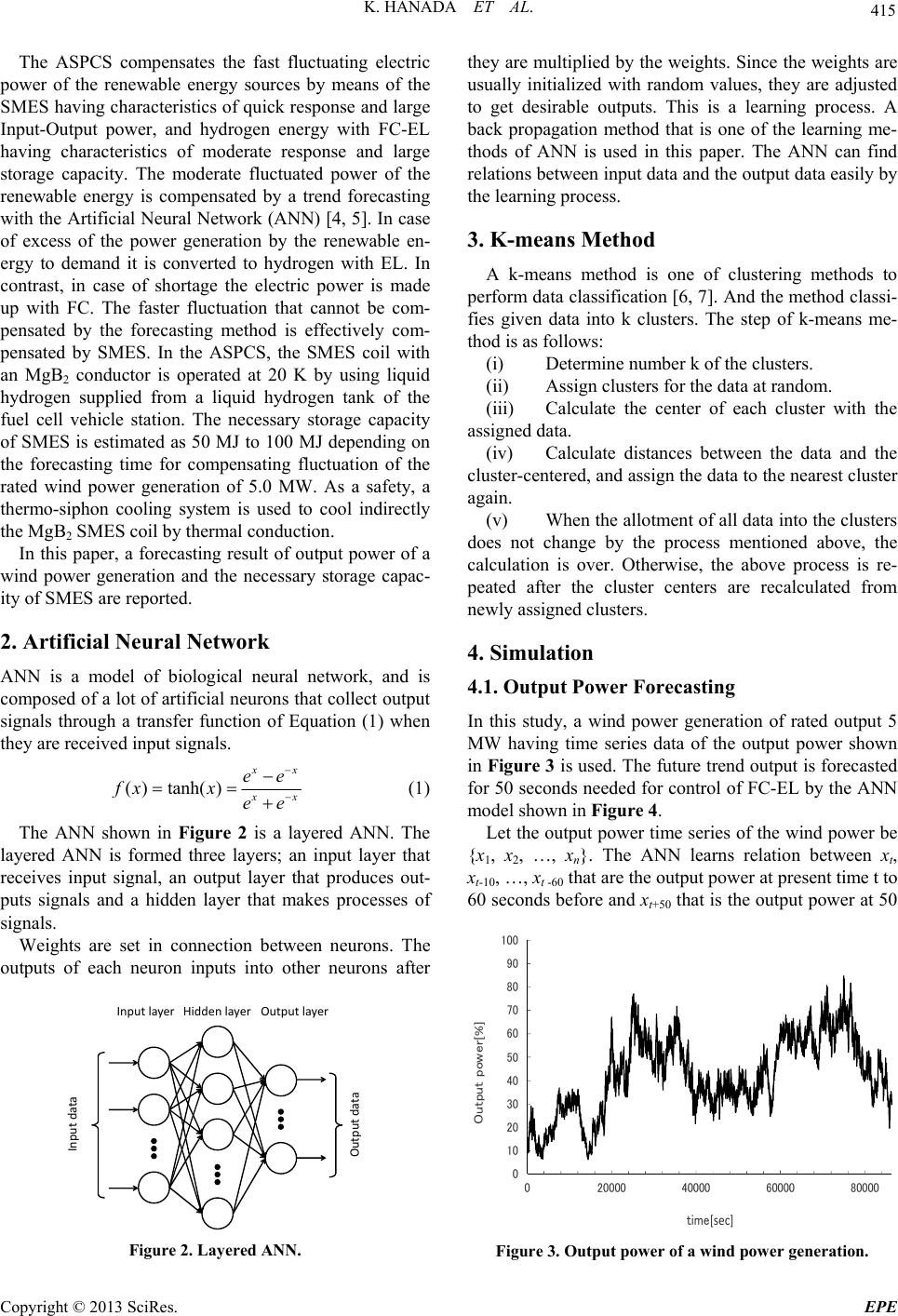
K. HANADA ET AL. 415
The ASPCS compensates the fast fluctuating electric
power of the renewable energy sources by means of the
SMES having characteristics of quick response and large
Input-Output power, and hydrogen energy with FC-EL
having characteristics of moderate response and large
storage capacity. The moderate fluctuated power of the
renewable energy is compensated by a trend forecasting
with the Artificial Neural Network (ANN) [4, 5 ]. In case
of excess of the power generation by the renewable en-
ergy to demand it is converted to hydrogen with EL. In
contrast, in case of shortage the electric power is made
up with FC. The faster fluctuation that cannot be com-
pensated by the forecasting method is effectively com-
pensated by SMES. In the ASPCS, the SMES coil with
an MgB2 conductor is operated at 20 K by using liquid
hydrogen supplied from a liquid hydrogen tank of the
fuel cell vehicle station. The necessary storage capacity
of SMES is estimated as 50 MJ to 100 MJ depending on
the forecasting time for compensating fluctuation of the
rated wind power generation of 5.0 MW. As a safety, a
thermo-siphon cooling system is used to cool indirectly
the MgB2 SMES coil by thermal conduction.
In this paper, a forecasting result of output power of a
wind power generation and the necessary storage capac-
ity of SMES are reported.
2. Artificial Neural Network
ANN is a model of biological neural network, and is
composed of a lot of artificial neurons that collect output
signals through a transfer function of Equation (1) when
they are received input signals.
( )tanh( )
x
x
ee
fxx ee
(1)
The ANN shown in Figure 2 is a layered ANN. The
layered ANN is formed three layers; an input layer that
receives input signal, an output layer that produces out-
puts signals and a hidden layer that makes processes of
signals.
Weights are set in connection between neurons. The
outputs of each neuron inputs into other neurons after
Inputlayer HiddenlayerOutputlayer
Inputdata
Outputdata
Figure 2. Layered ANN.
they are multiplied by the weights. Sin ce the weights are
usually initialized with random values, they are adjusted
to get desirable outputs. This is a learning process. A
back propagation method that is one of the learning me-
thods of ANN is used in this paper. The ANN can find
relations between input data and the output data easily by
the learning process.
3. K-means Method
A k-means method is one of clustering methods to
perform data classification [6, 7]. And the method classi-
fies given data into k clusters. The step of k-means me-
thod is as follows:
(i) Determine number k of the clusters.
(ii) Assign clusters for the data at random.
(iii) Calculate the center of each cluster with the
assigned da t a .
(iv) Calculate distances between the data and the
cluster-centered, and assign the data to the nearest cluster
again.
(v) When the allotment of all data into th e clusters
does not change by the process mentioned above, the
calculation is over. Otherwise, the above process is re-
peated after the cluster centers are recalculated from
newly assigned clusters.
4. Simulation
4.1. Output Power Forecasting
In this study, a wind power generation of rated output 5
MW having time series data of the output power shown
in Figure 3 is used. The future trend output is forecasted
for 50 seconds needed for control of FC-EL by the ANN
model shown in F igure 4.
Let the output power time series of the wind power be
{x1, x2, …, xn}. The ANN learns relation between xt,
xt-10, …, xt -60 that are the output power at present time t to
60 seconds before and xt+50 that is the output power at 50
0
10
20
30
40
50
60
70
80
90
100
020000 40000 60000 80000
Output power[%]
time[sec]
Figure 3. Output power of a wind pow er generation.
Copyright © 2013 SciRes. EPE